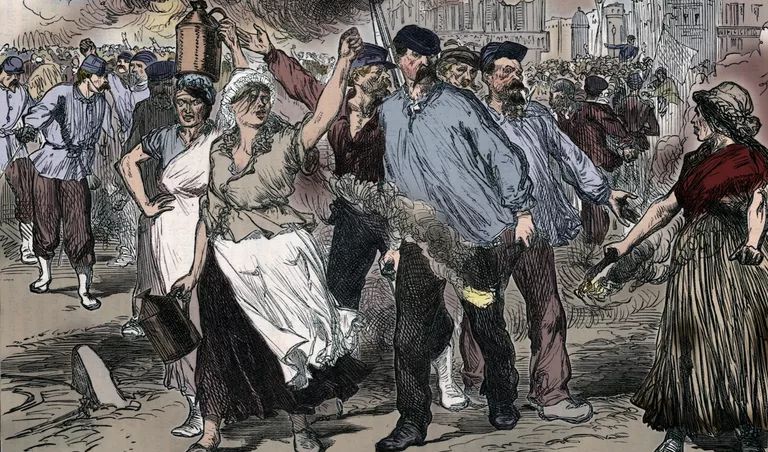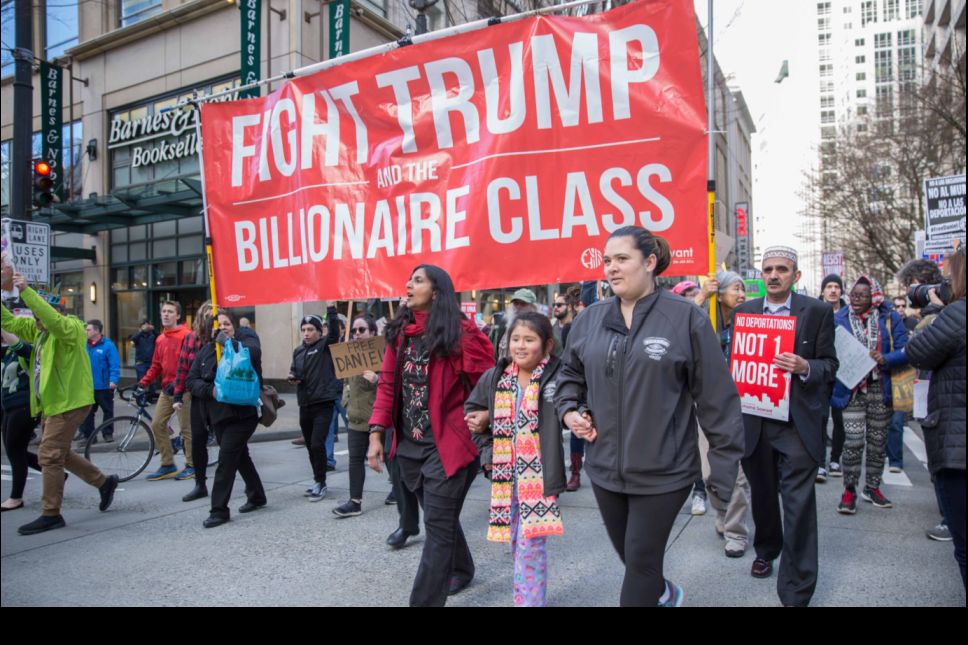Harper Cleves is a member of the Socialist Party (ISA in Ireland).
150 years ago this month, history was made when working-class Parisians established the Paris Commune on March 18, 1871. This represented the first example of a society run by and for the working class – a workers’ state. While the Commune lasted for only 72 days, it was able to implement social change that improved the lives of working-class men and women across Paris. Many of the changes achieved in a matter of weeks in a city run by ordinary Parisians in 1871, are changes that we are still fighting for in many parts of the world today.
Revolutions by the workers
In order to understand the consciousness of the radical working class of Paris in 1871, it is important to look back at the disappointed revolutionary efforts of the French working class in the preceding century. The Great French Revolution of 1789 that overthrew France’s feudal order was forged by the third estate – the self-proclaimed “common people” of France – in opposition to the first and second estates; the clergy and aristocracy. The third estate was not only composed of the property-owning bourgeoisie, but also the peasantry, the radical middle class, artisans, and the nascent working class. Unlike other bourgeois revolutions that had preceded it, such as the American Revolution, the “lower orders” of this estate (its non-bourgeois sections), organised around the Sans-culottes, managed to play a much more prominent and leading role in events.
The Sans-culottes, allied with the radical bourgeoisie in the Jacobins, had effective political power from 1792 until 1794 after the establishment of the first French Republic. The participation of the masses of French society in revolutionary struggle and in a revolutionary government in this period would leave an indelible mark on their consciousness and those of future generations, both in France and throughout Europe. The early utopian socialists, such as François-Noël Babeuf and Henri de Saint-Simon, who saw workers’ control and an end to class exploitation as a further democratic extension of the republican goals emerged from the left-wing of this movement.
Fast forward to 1848, and in February, amidst a wave of uprisings across Europe, the French monarch Louis Phillipe was overthrown and the Second Republic established. In June, following a conservative turn by the newly elected government, the working class of Paris revolted. The revolutionary movements of the 1830s – famously depicted in Victor Hugo’s Les Miserables – that preceded the 1848 revolution had revealed the true allegiances of the bourgeoisie, who had overwhelmingly favoured monarchy as a response to social unrest and the growing power of the working class. It was now clear that the French bourgeoisie could not claim to be among the “common people of France” as had been suggested in the politics of the third estate in 1789. The bloody 1848 rebellion was ultimately unsuccessful, and Louis Napoleon (nephew of Napoleon Bonaparte) was elected president. Three years later he suspended the elected assembly and declared the second French Empire under his reign as Emperor Napoleon III.
A revolution for the workers
The Franco-Prussian War, instigated by Napoleon III in a failed effort to prove the strength of the French Empire, ended with a long and difficult siege on Paris. The new French government, headed by Adolphe Thiers, surrendered to the Prussian army and quickly attempted to disarm Paris, particularly the National Guard, which was overwhelmingly working-class in its composition. This was no accident as Paris was a city composed of a working class that had been the driving force of all recent revolutionary efforts in France, whose material conditions continued to worsen at the hands of monarchs and elected officials alike, and who had just weathered a brutal attack by the Prussian forces.
The working class of Paris posed a threat to the state and therefore had to be disarmed. When the French troops attempted to remove canons from predominantly working-class and radical arrondissements (districts) such as Montmartre, thousands of women, men and children thwarted them, building barricades and driving the troops out of the city. The Commune, which had been on the lips of revolutionaries in the preceding unrest, was now declared. Paris would be run by and for workers.
Gains made by the Commune
Immediately, the newly-formed Commune set to work at creating a Paris that was run to serve rather than exploit its people. The revolutionaries within the Commune understood that in order to truly transform the social landscape of Paris, they required the mass involvement of the oppressed and exploited. On March 26, a new election was held to elect a General Council that reflected the new values of the Commune. Two hundred thousand French men voted and a third of those elected were members of the First International to which Marx and Engels also belonged. The results were met with huge celebrations.
Progressive changes that immediately improved the lives of ordinary working-class Parisians began to be implemented. First, in order to ensure that elected representatives and bureaucrats were not of a different class background and therefore placed above the average Parisian, it was decided that state functionaries would be paid an average workers’ wage, and were subject to immediate recall. Furthermore, foreigners living in the Commune were given immediate citizenship and allowed to vote. Church and state were separated and religion was made the private choice of the individual rather than the one imposed by the governing bodies. Particular emphasis was placed on removing church influences from schools. Hiring drives for secular teachers began, and women who were hired were paid equal to their male counterparts. Positions normally operated by privileged bureaucrats were turned over to manual workers with experience in the sector.
In order to ease the burdens on the working class evictions were banned, public canteens were set up, pawn shops – which were a predatory force in times of hardship in Paris where poor people felt compelled to sell off their items in order to put food on the table – were also banned.
Working-class Parisians for the first time had the opportunity to experience fine art, music and theatre, which had previously been exclusively the remit of the wealthy French bourgeoisie. Art began to be made publicly available. Mere days before the fall of the Commune, free and affordable concerts were being performed to public audiences, where people of all backgrounds could be seen mixing.
Parisians also sought to rid their city of the symbols of the previous regime. In a spontaneous action led by women, workers in Paris confiscated the guillotine, broke it down to pieces, and burned it. Today the guillotine is often seen as a symbol of the left, representing the end of cruel tyrants and monarchs, but at the time the guillotine was most often used against the radical middle class, working class, and poor. In destroying it, working-class women and men were destroying a symbol of state violence, overwhelmingly wielded against the exploited and oppressed.
Furthermore, in May of the Paris Commune, not long before its fall, the Vendôme Column was toppled. This column was a statue of Napoleon I and celebrated his military achievements, and the event was witnessed and celebrated by the working class and poor of Paris. Its toppling reflected an opposition to militarism and the colonial adventures of the French state. The renowned anthem, The Internationalé by Eugène Pottier, was written in this context of the burgeoning artistic achievements and shifting values of a Paris run by everyday Parisians. The English translation of the song seems to nearly recall the toppling of landmarks in these lines: “Servile masses, arise, arise! We’ll change henceforth the old tradition and spurn the dust to win the prize!”
The values of a city being run based on human need, and with an eye to the workers of the world, were being written onto the landscape itself.
The role of women
Working-class and socialist women, who are often confined to the sidelines of historical memory, were absolutely central to the enormous progress represented in the events of the Paris Commune. From the sudden emergence of the Commune, led by women blocking cannons and forming barricades, to the efforts women revolutionaries made to cut across the isolation of Paris: it is clear that women played a pivotal role in nearly every aspect of the Commune’s successes.
Many of the most progressive reforms instigated within the Commune were in part the product of socialist and left-wing women organising in the years preceding 1871. The First International, also known as the International Workingmen’s Association, was a heterogeneous organisation that represented many different tendencies of left-wing thought. Anarchists, socialists, trade unions, and what would later be deemed Marxists – revolutionary socialists who saw the working class as the central agent of social change.
The French section of the International was influenced by the anarchist Pierre-Joseph Proudhon who theorised women’s weakness, stupidness and immorality. In 1866, delegates influenced by these ideas passed a motion which stated: “From a physical, moral, and social viewpoint, women’s work outside the home should be energetically condemned as the cause of the degeneration of the race and as one of the agents used by the capitalist class.”
It should be said, however, these deeply sexist arguments were made in opposition to many of the prominent socialists who would later become leading communards.
This led to the need for prominent women socialists to challenge these backwards ideas, and begin organising in their own circles and collectives, while also working closely with the male socialists who fought back against these ideas in the French section of the International. André Leo, for instance, a novelist who wrote extensively on the oppression of women, in 1866 hosted the inaugural meeting of a new feminist group that would include many prominent citoyennes of the Commune: Paule Mink, Louise Michel, Eliska Vincent, and Noémi Reclus. They focused on improving the education of working-class girls. The work they did on this issue laid much of the groundwork for the removal of Church influence from schools, and the hiring of secular women teachers under the Commune.
Women joined political clubs in Paris throughout the 1860s and they had a particular influence in the more poor and working-class arrondissements. Socialist and working-class women who attended these clubs, some of which were mixed and some segregated, emerged as some of the leading voices of the Commune later on. They spoke about the right for women to work, the low wages women workers received, and the necessity of legal divorce. Women became even more active in the political clubs under the Commune. In one club a working-class woman warned citoyennes that marriage “is the greatest error of ancient humanity. To be married is to be a slave.” Another said she would never permit her 16 year old daughter to marry – and that women were happy to live with their lovers without the stamp of approval from the Church. At another club the clergy and bourgeoisie were labeled as being one and the same, recalling the relationship between the first and second estate before the 1789 revolution. Working-class women, who faced the worst cruelties of the prior regimes, were clear eyed about the nature of the system, and now increasingly saw themselves as political actors.
The Union of Women for the Defense of Paris, formed in response to the French government declaring war on Paris, was one of the most impactful organisations within the Commune and was born from these ideas discussed in political clubs, feminist groups, and working-class collectives even before the Commune. The Union provided staff for caregiving facilities for the elderly and children, as well as recruiting nurses. It also saw its task as political. It was the first French women’s organisation to describe gender discrimination as a tool that the ruling class used to foment its own power. Elisabeth Dmitrieff, one of the main leaders of the Union, was one of the original Russian signatories of the founding document of the International and she was in frequent communication with Marx throughout the duration of the Commune.
When the Commune fell, women experienced some of the most vicious attacks. They were raped and violated indiscriminately. Their bodies were disrobed by soldiers to be left exposed in the streets. In media depictions they were either hypersexualised and described in haughty, animalistic language, or made masculine and thus “unnatural.” The “natural” predilections of women imposed by the gender binary were used to discredit women who fought on behalf of the Commune. The breadth of attention paid to women communards by the French state demonstrated the threat they posed to the stability of the class-based society they were rebuilding from the ashes of the Paris they had ravaged.
Backlash from the French state
It was inevitable that a revolutionary moment of such a groundbreaking nature would involve significant mistakes, as there were few if any previous historical examples to draw on. One of the most often cited mistakes today is that the leaders of the Commune underestimated the hostility of the French state. While there could be no guarantees for the long-term survival of workers’ Paris, if the National Guard had immediately marched on the government in Versailles, taken control of the Bank of France (which contained enormous wealth belonging to the capitalist class), and made one of its main priorities to make connections with the working class and poor of France and other neighboring European countries, the chances for the longevity of the Commune would have increased significantly.
In fact Marx and Engels’ one amendment to later editions of the Communist Manifesto was based on the experiences of the Paris Commune. In this amendment they pointed to the true nature of the capitalist state, and that in order to transition towards a truly communist society the capitalist state must be overthrown completely, and all of its functions put in the hands of the working class en route to a further decentralisation of power – an idea further theorised in Lenin’s State and Revolution.(8)
What happened instead was that the state under the authority of Thiers responded with an almost unfathomable brutality. A conservative estimate suggests that 20,000 were murdered by the French state in the backlash. About 38,000 were arrested and more than 7,000 were deported. Against all international treaties, Thiers authorised for impromptu “trials” when hostages were being taken, allowing troops to kill indiscriminately without any tangible proof. Working-class accents almost guaranteed slaughter, and women and children were not spared. Bodies were left on the street even following the end of the official battle as a warning to those that remained. The ruling class was effectively waging a genocidal class war against revolutionary Parisian workers.
Interestingly, women communards took a firmer stance on the state in the early days of the Commune and throughout. When Versailles troops marched on Paris on April 2, one of the women’s papers wrote: “Let’s tell Versailles that Paris has made ready to defend herself because people tried to take her by surprise and disarm her. Let’s tell Versailles that the Assembly is not the law, Paris is.”
When taking up arms to defend the Commune, they referenced the women’s march on Versailles in 1789 when a huge storm of starving Parisians led by women sieged the Palace of Versailles and captured King Louis XVI and his family. Louise Michel, one of the leading women revolutionaries and the daughter of an unmarried servant, was one of the most ardent supporters of the siege of Versailles, knowing that if the Thiers government was not crushed, their efforts to overthrow the Commune would never abate.
Elisabeth Dmitrieff wrote to Marx that women in particular were adamant that the revolution must spread outside Paris, and she urged the general council of the International to appeal to the working class of other nations. Andre Léo was one of those responsible for writing a manifesto to rural workers called To The Workers of the Countryside, where she urged the working class and poor of France to join the Parisian cause. Working-class and revolutionary women were able to see the truth of the French state so clearly precisely because they were oppressed not only by the manufacturers, who paid them less than the men whom they also exploited in the factories, but also by the state which upheld high rents, high food costs and very little social support.
Lessons for today
In The Civil War in France which was released following the fall of the Paris Commune, Marx wrote: “Working men’s Paris, with its Commune, will be forever celebrated as the glorious harbinger of a new society. Its martyrs are enshrined in the great heart of the working class.”
The accomplishments of the Commune, achieved in a mere 72 days of workers’ control, demonstrated what society could look like if ordinary working people were in charge. The granting of citizenship to foreigners and the separation of church and state, both achieved in a matter of weeks under workers’ control, constitute reforms still fought for in many countries today.
The events in Paris in 1871, showed that the working class is not only capable of running society successfully for the good of all, but also that it is the primary agent for change. The endless exploitation of the working class in the name of profiteering for the few cannot last indefinitely. Revolutionary struggle, even as a spontaneous reaction of the exploited, is an inevitable outcome of capitalist excavation.
In the last 150 years, capitalism has created the conditions for countless revolutionary upheavals, some of which have seriously threatened its rule. Just like the men and women that brought the Paris Commune into existence, millions of working-class and poor people have sought to end the misery of their exploitation through collective struggle, and have faced the same reaction from those in power. A vital lesson of these movements, all of which had the potential to win, is that the absence of a mass, cohesive, revolutionary party – which could lead has prevented the working class from taking power and transforming society along socialist lines.
Does the fact that the Parisian working class took power in 1871 without such a party contradict this lesson? Not at all. The workers in Paris were the first to take such an audacious insurrectionary initiative, though they did so only in one city (for just ten weeks), and for that alone they should be celebrated and honoured by all workers today. But it’s not just workers who learnt from the experience of the Commune, the rulers the world-over did too. The revolution in Paris began with little initial resistance from the French ruling class – still reeling from the defeat of the Franco-Prussian war – who mounted a tactical retreat to the outskirts of Paris where they waited to regroup their armed forces before they struck back mercilessly.
The importance of a revolutionary party lies not just in leading the working class to seize power, but also, crucially, in maintaining it. Writing about the Paris Commune Leon Trotsky explained how the absence of such a force was a decisive impediment in the aftermath of the Commune’s initial victory: “This first success was a new source of passivity. The enemy had fled to Versailles. Wasn’t that a victory? At that moment the governmental band could have been crushed almost without the spilling of blood. In Paris, all the ministers, with Thiers at their head, could have been taken prisoner. Nobody would have raised a hand to defend them. It was not done. There was no organisation of a centralised party, having a rounded view of things and special organs for realising its decisions.”
A revolutionary party, having “a rounded view of things”, would have recognised the necessity of crushing the old French capitalist state and seizing its wealth and resources, as well as the need to spread the revolution to other parts of France and beyond. These lessons were assimilated by Lenin and the Bolsheviks, and ensured their success in Russia in 1917.
Today we are in a unique position. Not only do we have the benefit of access to the historical lessons of the revolutionary Paris Commune, the Russian Revolution, and numerous other revolutionary events, we also have a vastly strengthened working class. A working class that is more international, numerous, diverse and educated than it ever has been. The legacy of the Commune lives on today, as the crises of capitalism deepen and globally the exploited rise up to defend their dignity and struggle for a society worthy of them.




